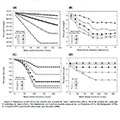Abstract
A briefly presented visual target stimulus can be difficult to identify if shown in the context of a mask stimulus. There are several quantitative models that have been used to explain many different masking effects. Here, we look at modeling what has been called object substitution. We analyze four models and show that three of the models work with a common principle, whereas the fourth behaves quite differently. The three similar models have previously been used to explain many other aspects of visual masking, whereas the fourth model was designed exclusively to deal with object substitution masking effects. We identify an experimental test on the basis of which to choose between the models. The experimental results support the behavior of the fourth model.
